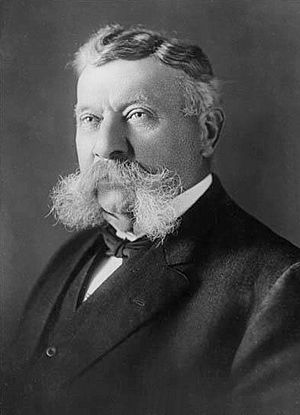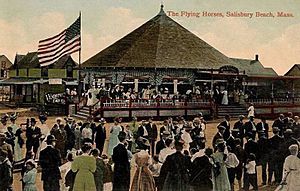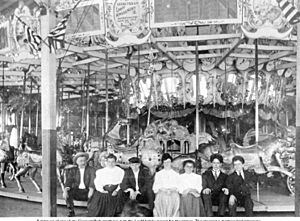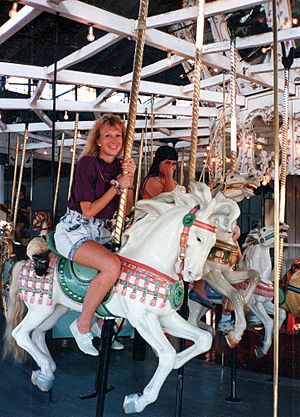Charles I. D. Looff facts for kids
Quick facts for kids
Charles I.D. Looff
|
|
|---|---|
 |
|
| Born | Carl Jurgen Detlev Looff May 24, 1852 Bad Bramstedt, Duchy of Holstein, German Confederation
|
| Died | July 1, 1918 (aged 66) |
| Occupation | Builder and carver of carousels and amusement rides |
| Spouse(s) | Anna Dolle |
| Children | Anna (1875-1896) Helen (1877-1956) Emma (1879-1938) Charles (1881-1924) William (1883-1945) Arthur (1888-1970) |
| Parent(s) | Jurgen Detlef Christian Loeff (father) |
Charles I. D. Looff was a skilled German artist. He was famous for carving and building beautiful carousels and fun amusement rides. He moved to the United States in 1870.
Looff built the very first carousel at Coney Island in 1876. During his life, he created over 40 carousels. He also built several amusement parks, many roller coasters, and Ferris wheels. He even built California's famous Santa Monica Pier. Charles Looff became well-known for his special "Coney Island style" of carousel carving.
Contents
Early Life of Charles Looff
Charles Looff was born Carl Jürgen Detlev Looff on May 24, 1852. He was born in Bad Bramstedt, which was part of the German Confederation then. His father, Jürgen Detlef Christian Looff, was a master blacksmith and wagon builder. Young Carl learned how to work with metal and wood by watching his father.
To avoid a coming war, Carl moved to the United States. He arrived in New York City on August 14, 1870. When he arrived, he changed his first name to Charles. Because the letters I and J look similar in low German, his name became Charles I. D. Looff by mistake.
Charles settled in Greenpoint, Brooklyn. He found a job carving furniture. He also taught ballroom dance part-time. In 1874, he met and married Anna Dolle, who was also from Germany.
After working all day, Charles would take wood scraps home. He started carving them into carousel animals in his apartment. He put his wooden horses and animals onto a round platform. This was his first merry-go-round. In 1876, he set up his ride at Lucy Vandeveer's Bathing Pavilion. This was Coney Island's first carousel and its first amusement ride.
Looff opened a factory in Brooklyn. He continued to build more carousels. He put a merry-go-round at a restaurant in Coney Island. This restaurant was owned by Charles Feltman, who invented the American hot dog. Looff also built a big ride for Asbury Park, New Jersey. As his business grew, Looff hired other expert carvers.
Charles and Anna had six children. All of them, except Anna, who died young, helped their father in the carousel business. When the city took his property to build a park, Looff moved his family. They moved to Crescent Park in Riverside, Rhode Island.
Rhode Island Years and Famous Carousels

In 1886, Colonel George Boyden started an amusement park called Crescent Park. It was in Riverside, Rhode Island, and overlooked Narragansett Bay. Boyden asked Charles I. D. Looff to build a large carousel there. This carousel was at the end of a long pier. Many people came to the park by steamboat. Crescent Park became known as "the Coney Island of the East."
In 1895, Looff built an even bigger and more detailed carousel at Crescent Park. This beautiful ride has 61 horses, 1 camel, and 4 chariots. He used this ride to show what he could do. Buyers could choose the types of carved animals for their own carousels. Looff built his workshop right next to this carousel. Here, he made many merry-go-rounds for parks all over the United States.
Looff's daughter, Helen, and her husband bought this ride in 1930. Today, the city of East Providence, Rhode Island owns it. It has been fully restored and still runs in its original spot. It was added to the National Register of Historic Places in 1976. In 1985, Rhode Island called it the "State Jewel of American Folk Art." In 1987, it became a National Historic Landmark.
Charles Looff's son, Charles Jr., worked in the shop. He carved saddles and chariots for his father. In 1920, Charles Jr. bought Crescent Park and ran it until he died in 1925. He also built a boat called the Miss Looff. It brought customers from Providence, Rhode Island and Newport, Rhode Island to Crescent Park.
In the early 1900s, Looff built carousels and figure-8 roller coasters. These were for the Texas and Oklahoma state fairs.
In 1909, Charles I. D. Looff built a beautiful carousel with 54 horses. He gave it to his daughter, Emma, as a wedding gift. This ride was set up at Natatorium Park in Spokane, Washington. It has been restored and still runs today at Riverfront Park in Spokane.
California Adventures and Legacy
Charles I. D. Looff loved the idea of building amusement parks on the West Coast. In August 1910, he moved to California. He left his daughter Helen and son Charles Jr. to manage the family's businesses in Rhode Island. Charles I. D. Looff settled in Long Beach, California. He built a factory there.
He bought land at The Pike, a fun area on Long Beach's waterfront. There, he built a wonderful merry-go-round. His family lived in an apartment above the ride. His son, Arthur, also ran a game called Lite-a-Line at the Pike. This game is still running today in Long Beach. A small museum honoring Looff's work is also there. Sadly, a fire destroyed the Pike carousel in 1943. Arthur replaced it with another Looff merry-go-round.
In 1916, Looff and his son, Arthur, designed and built Looff's Santa Monica Pier. They built a large, fancy building called the "Hippodrome" to hold one of their beautiful carousels. This carousel is now known as the Santa Monica Looff Hippodrome. The Looffs also built the Blue Streak Racer wooden roller coaster on their new pier. They added other rides like The Whip.
Besides Santa Monica and the Pike, Looff built and ran amusement parks and carousels in other California cities. These included Ocean Park, Redondo Beach, Venice Beach, and Santa Cruz. He also built the carousel at Griffith Park in Los Angeles, which still runs today. This particular carousel helped inspire Walt Disney to create Disneyland and Disney World. Disneyland even has the park bench where Disney sat and watched his daughters ride the merry-go-round. He dreamed of a new kind of theme park there.
Looff also built a short-lived amusement park in Seattle called Luna Park. The carousel for Luna Park was first planned for San Francisco. But the famous 1906 San Francisco earthquake made Looff build Luna Park in Seattle instead. Today, that carousel has returned to San Francisco.
Charles I. D. Looff died on July 1, 1918, in Long Beach, California. After he passed away, his son Arthur continued to manage the family's West Coast business. This included building the Giant Dipper roller coaster at the Santa Cruz Beach Boardwalk.
The Santa Monica Looff Hippodrome and the Santa Cruz Looff Carousel and Roller Coaster were both named National Historic Landmarks in 1987.
Notable Looff Carousels
| Year | Name | Original location | Notes |
|---|---|---|---|
| 1876 | Vandeveer's Bathing Pavilion Carousel | Coney Island, New York | The first of over 25 carousels at Coney Island. |
| 1877 | Feltman's Carousel | Feltman's Beer Garden, Coney Island, New York | Partially burned in a fire. |
| 1884 | Roger Williams Park Carousel | Providence, Rhode Island | Moved to Slater Park, Pawtucket, Rhode Island, in 1910. Listed on National Register of Historic Places. |
| 1886 | Midland Beach Carousel | Staten Island, New York | Moved to Keansburg, New Jersey in 1913. Operated until 1985. |
| 1888 | Wesley Lake Carousel | Asbury Park, New Jersey | All horses had real horsehair tails. Operated until 1988. |
| 1890 | Broadway Flying Horses Carousel | Coney Island, New York | Moved to Salisbury, Massachusetts and then to Seaport Village, San Diego, California, in 1980. |
| 1891 | Rocky Point Amusement Park Carousel | Warwick, Rhode Island | Looff also built a Ferris Wheel here. |
| 1895 | Crescent Park Carousel | Riverside, East Providence, Rhode Island | Used by Looff as a showcase. Still operational with brass rings. Listed on National Register of Historic Places. |
| 1896 | Savin Rock Park Carousel | West Haven, Connecticut | Moved to Lake Compounce, Bristol, Connecticut in 1911. |
| 1898 | Burlington Island Park | Burlington, New Jersey | Moved to Seaside Heights, New Jersey in 1932. Survived Hurricane Sandy in 2012. |
| 1898 | Canobie Lake Park Carousel | Salem, New Hampshire | Moved to present location in 1906. |
| 1898 | Sherman's Carousel | Caroga Lake, New York | Looff building with stained glass windows. Original animals were sold. |
| 1903 | Lakeside Park Carousel | Port Dalhousie, Ontario | Moved to present location in 1921. |
| 1904 | Fair Park Carousel | Dallas, Texas | Moved several times, now at Seaport Village, San Diego, California. |
| 1906 | The Children's Creativity Museum—LeRoy King Carousel | Yerba Buena Gardens, San Francisco, California | Built for San Francisco, sent to Seattle due to earthquake, returned to San Francisco in 1914. |
| 1908 | Lighthouse Point Park Carousel | New Haven, Connecticut | Moved to present location in 1916. |
| 1909 | Natatorium Park | Spokane, Washington | A wedding gift for Looff's daughter Emma. Still operational at Riverfront Park. A National Historic Landmark. |
| 1911 | The Pike Carousel | Long Beach, California | Burned down in 1943. |
| 1911 | Santa Cruz Beach Boardwalk Carousel | Santa Cruz, California | A National Historic Landmark. Still in use at its original location with brass rings. |
| 1916 | Santa Monica Pier Carousel | Santa Monica, California | The Looff Hippodrome carousel building is a National Historic Landmark. |
| 1926 | Griffith Park Merry-Go-Round | Griffith Park, Los Angeles, California | Still running. Inspired Walt Disney to create Disneyland. |



